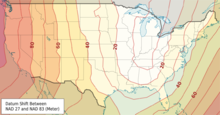- North American Datum
-
Geodesy 
Fundamentals Geodesy · Geodynamics
Geomatics · CartographyConcepts Datum · Distance · Geoid
Figure of the Earth
Geodetic system
Geog. coord. system
Hor. pos. representation
Map projection
Reference ellipsoid
Satellite geodesy
Spatial reference systemTechnologies GNSS · GPS · ... Standards ED50 · ETRS89 · NAD83
NAVD88 · SAD69 · SRID
UTM · WGS84 · ...History History of geodesy
NAVD29 · ...This article needs additional citations for verification. Please help improve this article by adding citations to reliable sources. Unsourced material may be challenged and removed. (September 2010) The North American Datum is the official datum used for the primary geodetic network in North America. In the fields of cartography and land-use there are currently two North American Datums in use: the North American Datum of 1927 (NAD27) and the North American Datum of 1983 (NAD83). Both are geodetic reference systems, but each is based on different measurements.
Contents
North American Datum of 1927
The North American Datum of 1927 (NAD27) is based on the Clarke Ellipsoid of 1866; it was created by manual surveying of the entire continent. The geodetic "center" of NAD27 is a base station at Meades Ranch in Kansas.
Ellipsoid Semimajor axis† Semiminor axis† Inverse flattening†† Clarke 1866 6,378,206.4 m 6,356,583.8 m 294.978698214 †By definition. ††Calculated.
These are the defining dimensions for NAD27, but Clarke actually defined his 1866 spheroid as a = 20,926,062 feet, b = 20,855,121 British feet. The conversion to meters uses Clarke's 1865 inch-meter ratio of 39.370432. In a practical sense, the length of a foot or meter at the time could not be benchmarked to better than about 0.02 mm,[1] so the meter equivalents used now can be considered exact to well beyond the uncertainties in the lengths and conversion values of the time.
North American Datum of 1983
Because Earth deviates significantly from a perfect ellipsoid, the ellipsoid that best approximates its shape varies region by region across the world. Clarke 1866, and North American Datum of 1927 with it, were surveyed to best suit North America as a whole. Likewise, historically most regions of the world used ellipsoids measured locally to best suit the vagaries of earth's shape in their respective locales. While ensuring the most accuracy locally, this practice makes integrating and disseminating information across regions troublesome.
As satellite geodesy and remote sensing technology reached high precision and were made available for civilian applications, it became feasible to acquire information referred to a single global ellipsoid. This is because satellites naturally deal with Earth as a monolithic body. Therefore the GRS 80 ellipsoid was developed for best approximating the earth as a whole, and it became the foundation for the North American Datum of 1983. Though generally GRS 80 and its close relative WGS 84 are not the best fit for any given region, a need for the closest fit largely evaporates when a global survey is combined with computers, databases, and software able to compensate for local conditions.
Ellipsoid Semimajor axis† Semiminor axis†† Inverse flattening†† GRS 80 6,378,137 m 6,356,752.3141 m 298.257222101 †By definition. ††Calculated.
Comparisons Between NAD27 and NAD83
A point having a given latitude and longitude in NAD27 may be displaced on the order of many tens of meters from another point having the identical latitude and longitude in NAD83, so it is important to specify the datum along with the coordinates. The North American Datum of 1927 is defined by the latitude and longitude of an initial point (Meades Ranch in Kansas), the direction of a line between this point and a specified second point, and two dimensions that define the spheroid. The North American Datum of 1983 is based on a newer defined spheroid (GRS 80); it is an Earth-centered (or "geocentric") datum having no initial point or initial direction.
North American Datum 83 and WGS84
The initial definition of NAD83(1986) was intended to match GRS80 and WGS84, and many older publications indicate no difference. Subsequent more accurate measurements found a difference typically on the order of a meter over much of the US. Each datum has undergone refinements with more accurate and later measurements.
One fundamental difference is that NAD83 is defined to remain essentially constant over time for points on the North American tectonic plate, whereas WGS84 is defined with respect to the average of stations all over the world. Thus there is a change over time as to the difference between the systems. For much of the US the relative rate is on the order of 1 to 2 cm per year.
Latest version of North American Datum
The US National Spatial Reference System of 2007 (NSRS2007), also called NAD83(2007), is a refinement of the NAD83 datum using data from a network of very accurate GPS receivers at Continuously Operating Reference Stations (CORS).
See also
References
- ^ Cardarelli, Francois Encydopaedia of scientific units, weights, and measures: their SI equivalences and origins, Springer-Verlag London Limited 2003, ISBN 1-85233-682-X, page 5, table 2.1, data from Giacomo, P., Du platine a la lumiere, Bull. Bur. Nat. Metrologie, 102 (1995) 5–14.
External links
- NADCON – a free utility for Microsoft Windows to convert between NAD27 and NAD83
- nadcon.prl – a web-based utility for NADCON
- NAD27: What Is It and Why You Should Care by Dane E. Ericksen, P.E., Hammett & Edison, Inc., Consulting Engineers. 1994 SBE National Convention and World Media Expo.
Categories:- Geodesy
- Cartographic projections
Wikimedia Foundation. 2010.


